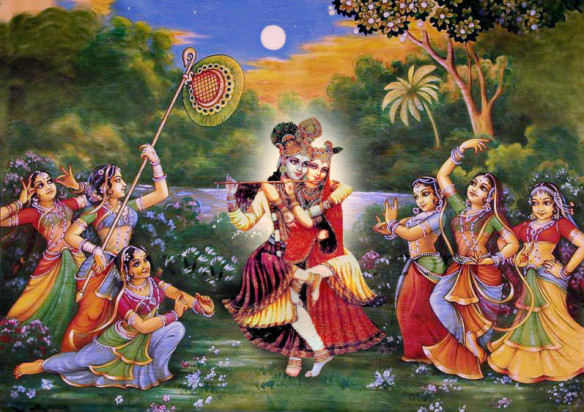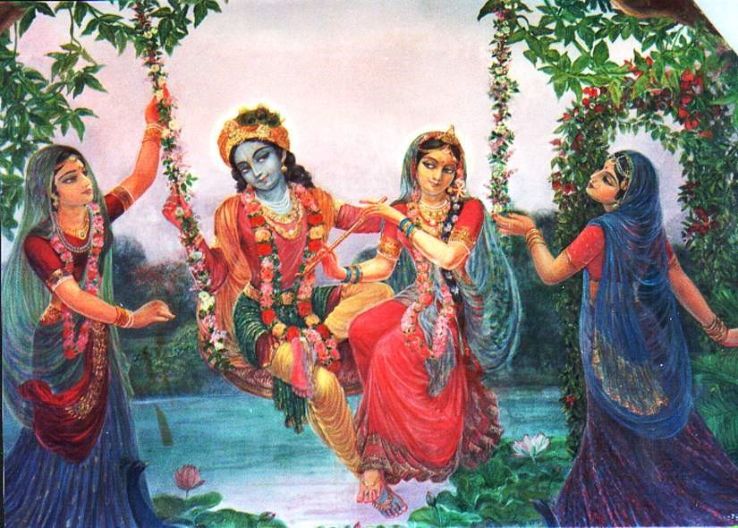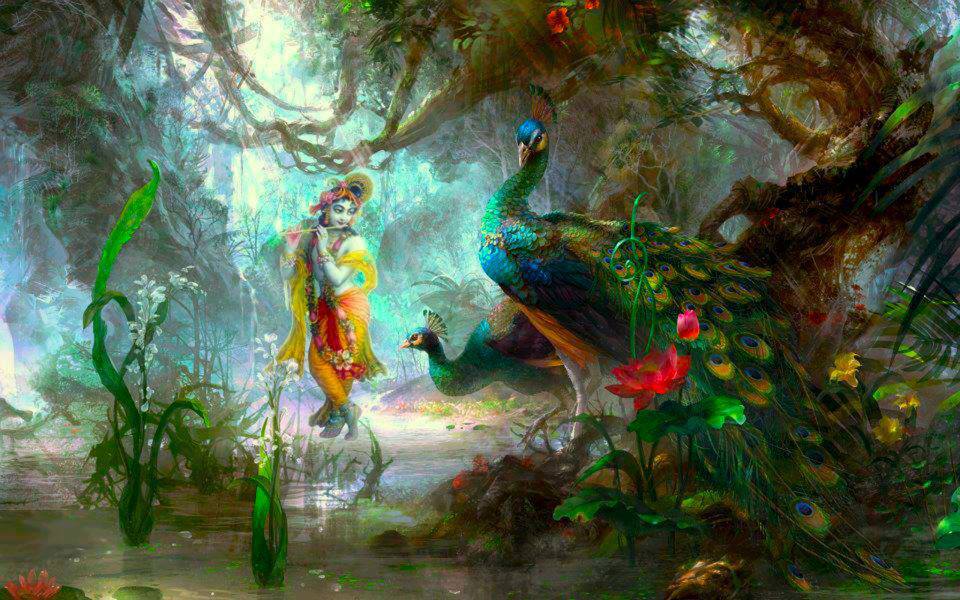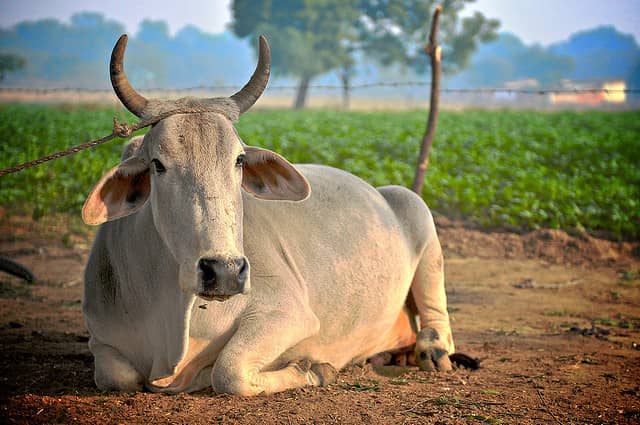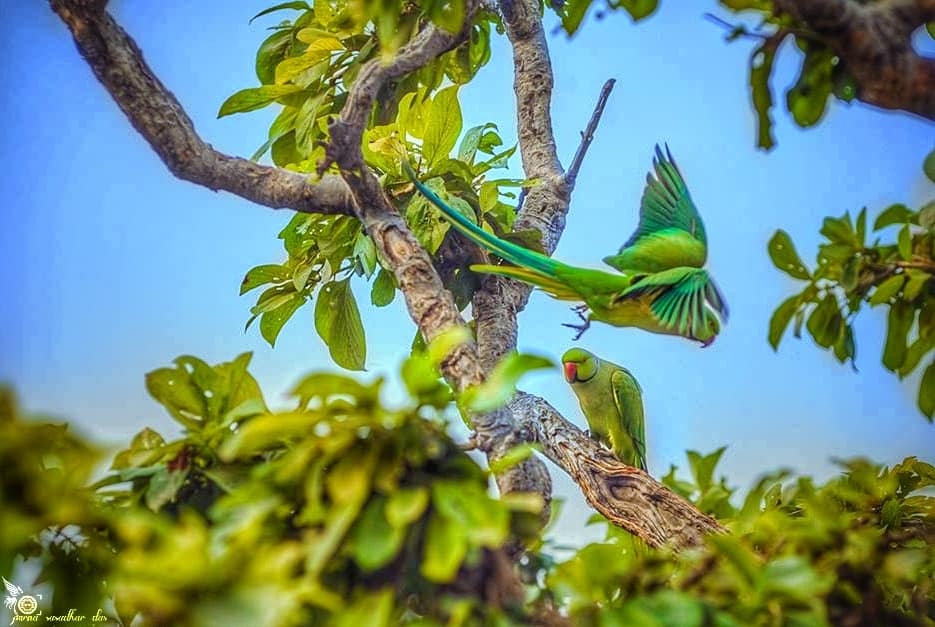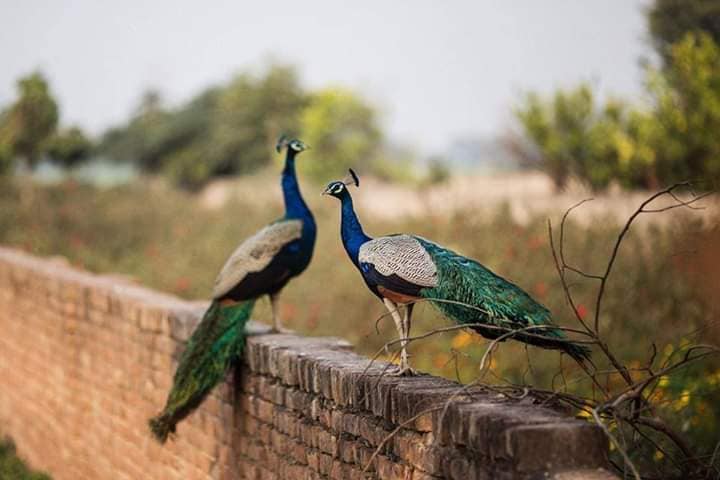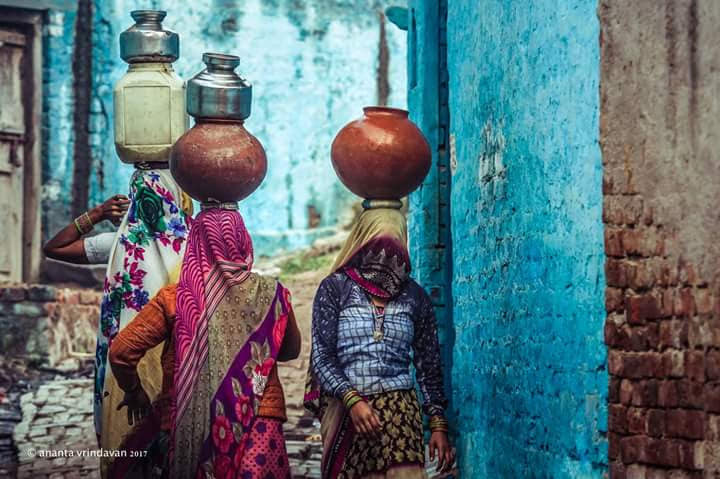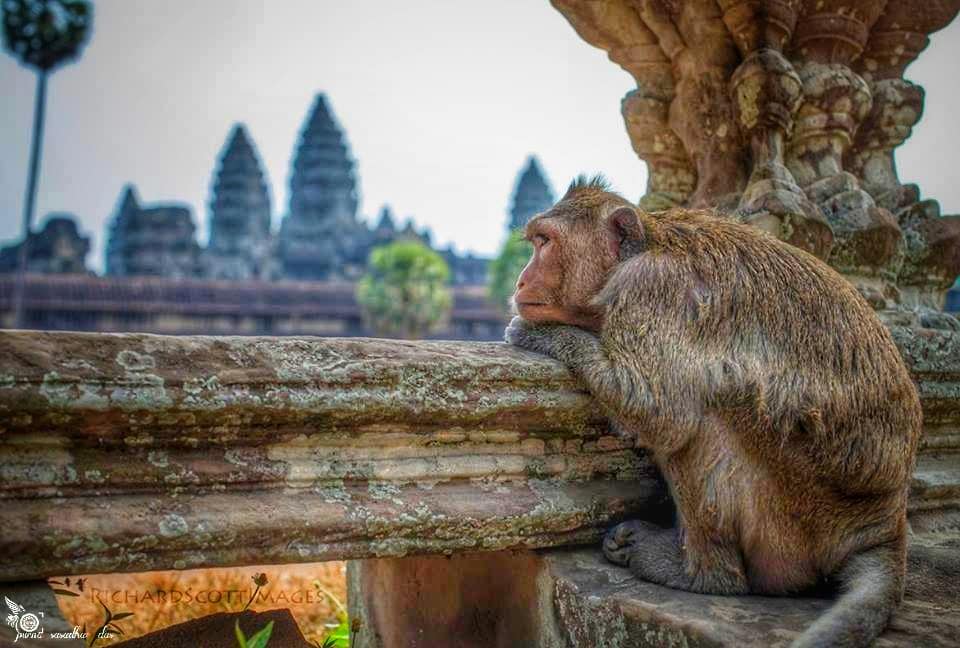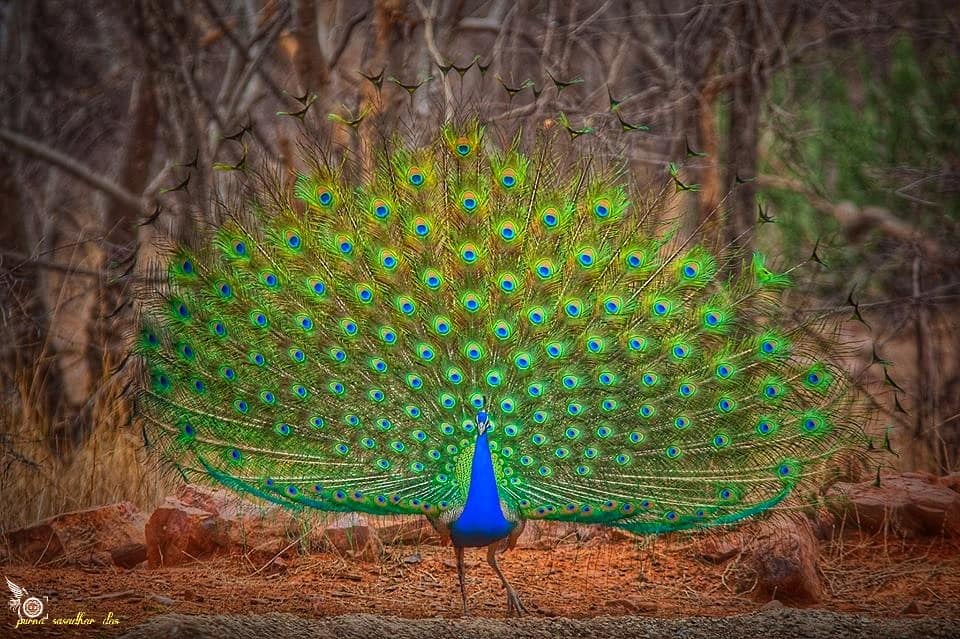Mahanidhi Madan Gopal Das
From Shravan month, sukla tritiya “Hariyali Teej” until Shravan Purnima, all the Thakurjis in Vraj enjoy Their annual twelve-day blissful rainy season swing festival (jhulanotsava). Below are translations of popular Hindi and Bengali jhulan bhajans, you can meditate upon while chanting Hare Krishna maha-mantra japa.
Radha-Krishna Jhulan Lila Meditation Japa Chanting Technique
** Copy and save this post on your mobile. Since all of Radha Govinda’s lilas are eternal, nitya-lila you can chant japa with these meditations anytime or the year. By doing lila japa you will feel very satisfied, spiritually refreshed and blissful in your heart.
This is the proper way to chant Hare Krishna nama japa; hear, chant and deeply remember the eternal asta-kaliya lilas of Sri Sri Radha-Krishna in Vrndavana.
Jai Jai Sri Radhe!
1) Before japa, first slowly read one bhajan translation. While reading, try to visualize Sri Sri Radha-Krishna, the sakhis and manjaris, the forest scene, and all the props.
2) Slowly read again, increasing the visualization while trying to identify with the feelings and sevas of the sakhis and manjaris caring for Lila Yugal.
3) Close your eyes, try to recapture the scene, sevas and feelings being exchanged between the sakhis, manjaris, and Sri Sri Radha Govinda Yugal.
4) Open your eyes, read the entire piece again out loud.
5) Close your eyes and begin chanting japa while trying to mentally see, feel, enter into, and serve everything you just read about.
Without a doubt, if you do this sincerely you will have an amazingly sublime and sweet experience during your jhulan lila japa meditations.
Jhulan Lila Japa Meditations
# 1 The sakhis gossip from house to house in Varsana: “Hey sakhi! Quickly, dress and let’s go meet gallant Shyamasundara.”
Lalita and Vishakha dress Radhika, and then everyone rushes to the Jhulan site. Radhika and the sakhis joke and laugh in great fun.
Upon meeting Shyam, they burst with joy. Radha’s loving eyes meet Shyams and Their minds spin with amorous desires.
Mohana dasa observes this lila in great happiness, as Rasik Yugal swing together being as the gopis push back and forth.
# 2 Shyam inebriates with the joy of jhulan swinging with golden Radha on His left, jhulato shyam, gauri bama—ananda range matiya). Exchanging mild smiles, Radha-Shyam arouse amorous mutually moods.
Radhika sweetly gestures to Her sakhis to push the swing. Swarms of bees hover around the fragrant flowers decorating the golden swing. Shyam looks like a rain cloud as the playful Rai embraces His left side like a brilliant lightning strike.
Dangling necklaces and moon lockets toss about as Radha-Shyam embrace. Mrdangas enchantingly pound, bi-dhi, bi-dhik, a-di-ya; tini-na, tini-na, and ta-ti-ya!
The indescribable atmosphere is saturated with the gopis’ high-pitched singing of jhulan bhajans.
Mixing sweetly with the jhunara (large karatals), their bangles, ankle bells and waist bells resound—jha-na, jha-na, jha-na, jha-ti-jha! Overcome with joy, Uddhava dasa takes shelter at the lotus feet of Radha-Mohana.
# 3 “Sakhi, look! As Yugala-kishora look like a blue sapphire set in gold as They swing.” Lalita and Vishakha happily push the swing while relishing the beauty of Their faces. Rai’s playful sakhis surround the flower decorated swing and dense rainclouds rumble overhead.
The sakhis drown in ecstasy as they swing the Divine Couple. Some sakhis clap their hands gleefully while telling lovely-faced Radha, “Tightly hold Your Pranavallabha so You don’t fall off the jhulan!”
As Radha-Shyama swing faster and faster, Their hair loosens and beads of perspiration, like drops of nectar, glide down their moon-like faces. To relieve Radha-Shyama’s fatigue, the sakhis wave chamaras.
The bees and cuckoos watch from the trees and sing out, “Jaya Jaya Radha-Krishna! Jaya Radha-Krishna!”
Padakarta Jagannatha dasa says, “O when will I behold Yugala-kishor’s beautiful jhulan-lila in the groves of Vrindavan?”
# 4 Sweet-faced Radha on His left, the topmost gallant lover floates in an ocean bliss while joyfully swinging on the elegant hindola. The amazing sight of their matchless beauty captivates the universe!
The irresistible enchantment of Radha’s beautiful face and enticing eye gestures induces Shyam to kiss Kishori again and again. Radha’s voice falters as Cupid’s spell seizes Shyama-Shyam!
# 5 The sakhis say, “O Vrishabhanunandini! Auspicious teej has come, so let’s go swing in the cool breeze of monsoon! Black clouds shower tiny rain drops and enthrall everyone with their romantic rumbling.
O Kishori! O Karunamayi Radhe, who takes away everyone’s misery! The beautiful swings on the kadamb trees anxiously await to serve Your exquisitely divine form.
O Vrajeshvari! Please accept our humble request. Wear a bright, colorful sari and come to the jhulan. A gentle smile adorns Your lovely, softly glowing beautiful face which shames the radiance of the moon.”
# 6 O Radhe, costly ornaments adorn Your splendid form, and kajal accents the elegance of Your lotus eyes. O Pyarijeu! Please come for jhulan and bless the anxious monsoon clouds.
O most wise and learned Vrishabhanu-dulari, please give up your angry disposition toward Shyam.
Your beloved Rasika Pritam eagerly waits for You. When Vilasini Radha arrives at the jhulan, Krishna folds His hands in surrender and says, “O Shyamajiu! I submit to Your lotus feet.”
# 7 O Bihariji! You forever relish swing pastimes in Vrindavan. Just see how the keli -kunjas of Vraja are covered with a blanket of green! Here stands Nandabihari and Bhanudulari. O how sweet the Divine Couple look in our eyes! Wearing dazzlingly artistic clothing, You both look so beautiful standing beside the Yamuna.
The kadamb trees blossom with an abundance of fragrant flowers. The shining black luster of Ghanashyam mixes with the resplendent golden hue of Radha like a lightning flash in a raincloud. This incredible sight our hearts with bliss. Shyam’s chakora eyes relish every drop of sweet nectar mercifully dripping from the rasa moon of Madhuri’s countenance. Excited sakhis serve Their every wish.
# 8 At midday, Sri Radha and the sakhis walk to the jhulan mandap. Beautiful blossoming kalpa vrksha trees stand on all sides. The fragrant creepers of madhavi and malati wrapped around the intertwining, densely foliated, bending branches of the trees to form a natural canopy overhead. The pleasure swings hanging from the trees have comfortable seats with soft cushions and pillows.
On the pretext of admiring the forest beauty, Sri Krishna slips away from the boys and cows. With His confidantes Subala and Madhumangala, Krishna quickly goes to meet Radhika and the sakhis. Some sakhis and manjari expertly play vinas, drums and other instruments. And other lovely damsels of Vraja sing and dance for the pleasure of Priya-Priyatam.
With their sweetest possible voices, the cuckoos and parrots join the concert, and the peacocks fan their tails while ecstatically shrieking “Ke Ka! Ke Ka!”
Bees buzz, deer frolic and the entire forest vibrates with festive bliss. Radha-Shyama and Their intimate sakhis sit together in the center of the spectacular thousand-petal lotus jhulan. Nearby on other swings, different yutheshvaris sit with their sakhis.
On her swing in the east is Candravali and her party; south, Bhadra and her sakhis; north, Shyamala and friends; and wes, Dhanya and company. Hovering in their transports, devas and devis happily observe the jhulan utsav from the sky.
Just to make it a super spectacle bliss festival, Vrinda-devi mixes in Holi too! She and her allies bring heaps of colored powders made of pulverized fragrant flowers; flowers bombs, and powerful one meter syringes to completely drench everyone in festive colors of joyful love.
“Preme Se! Preme Se!” Holi Hey! Holi Jhulan Utsava ki jai! Radha’s yutheshvaris team up to bombard Lila Yugal with clouds of color, and streams of rainbow-hued liquids shot from their gem-studded golden syringes (huge squirt guns).
Clever Lalita and Her sakhis form a human shield all around Yugal to protect Radha-Govinda from the attack. In seconds, the sakhis are simultaneously wet and dusted from the torrents of colored liquids, powders and flower bombs. The color monsoon turns the day into night.
After some time, the dense powder clouds settle, and the sakhis get off their individual swings to eagerly push Radha-Shyam’s jhulan. Due to the rapid swinging, Radha-Madhava’s malas start to oscillate. Nectar thirsty bumblebees try to land on these malas. But they end up just chasing the jhulan back in forth without getting any nectar.
Krishna then enjoys jhulan with different partners each taking turn. First Radha, then Lalita and all others. Descending from the swing, Radha seats a pair of sakhis on Shyam’s sides, and personally pushes the swing in great joy. Then Shyama gets off and pushes Priyaji and Her dearest gopis.
When Jhulan ends, the kinkaris relieve the Prem Yugal by fanning Them, daubing Them with sandalwood paste, and offering Them tasty sweet fruits and refreshing cool drinks. (Gutika, adapted)
Jhulan japa meditation ki jai! Sri Sri Radha Govinda Yugal Jhulan Utsav ki jai!
JAI JAI SRI RADHE!

